Spatiotemporal Uncertainty and Sensitivity Analysis of the SIMPLE Model Applied to Common Beans for Semi-Arid Climate of Mexico
Abstract
1. Introduction
2. Materials and Methods
2.1. Data Collection
2.2. SIMPLE Crop Growth Model
2.3. Uncertainty Analysis (UA)
| Parameter | Description | Units | Min | Max | Source |
|---|---|---|---|---|---|
| Tsum | Accumulated temperature from planting to maturity | °C day | 960 | 1440 | [39] |
| HI | Harvest index | -- | 0.288 | 0.432 | [39] |
| I50A | Accumulated temperature required for leaf area development to intercept 50% of radiation | °C day | 360 | 540 | [25] |
| I50B | Accumulated temperature to maturity to reach 50% radiation interception due to leaf senescence | °C day | 160 | 240 | - |
| Tbase | Baseline temperature for phenology development and growth | °C | 6.4 | 9.6 | [39] |
| Topt | Optimum temperature for biomass growth | °C | 22 | 32 | [39] |
| RUE | Radiation use efficiency (above ground only and no respiration) | g MJ−1 m−2 | 2.568 | 3.852 | [40] |
| I50maxH | Maximum daily reduction in I50B due to heat stress | °C day | 72 | 108 | [25] |
| I50maxW | Maximum daily reduction in I50B due to drought stress | °C day | 16 | 24 | [25] |
| Tmax | Threshold temperature to start accelerating heat stress senescence | °C | 32.1 | 42 | [41] |
| Text | Extreme temperature threshold when RUE becomes 0 due to heat stress | °C | 42.1 | 52.5 | [25] |
| Sco2 | Relative increase in RUE per ppm of CO2 after 350 ppm | ppm | 0.056 | 0.084 | [25] |
| Swater | Sensitivity of RUE to drought stress | -- | 0.72 | 1.08 | [25] |
2.4. Global Sensitivity Analysis
3. Results
3.1. Climatic Conditions
3.2. Uncertainty Analysis
3.3. Sensitivity Analysis
4. Discussion
4.1. Climatic Conditions
4.2. Uncertainty Analysis
4.3. Sensitivity Analysis
5. Conclusions
Author Contributions
Funding
Data Availability Statement
Acknowledgments
Conflicts of Interest
References
- Hayat, I.; Ahmad, A.; Masud, T.; Ahmed, A.; Bashir, S. Nutritional and health perspectives of beans (Phaseolus vulgaris L.): An overview. Crit. Rev. Food Sci. Nutr. 2014, 54, 580–592. [Google Scholar] [CrossRef] [PubMed]
- Centro de Estudios para el Desarrollo Rural Sustentable y la Soberanía Alimentaria (CEDRSSA). Mercado del Frijol, Situación y Prospectiva. 2020. Available online: http://www.cedrssa.gob.mx/files/b/13/53Mercado%20del%20frijol.pdf (accessed on 15 April 2022).
- Servicio de Información y Estadística Agroalimentaria y Pesquera Información Agrícola (SIAP). Avances Mensuales por Estado. Estadisticas 2010–2010. 2021. Available online: https://www.siap.sagarpa.gob.mx (accessed on 15 May 2021).
- van Ittersum, M.K.; Leffelaar, P.A.; van Keulen, H.; Kropff, M.J.; Bastiaans, L.; Goudriaan, J. On approaches and applications of the Wageningen crop models. Eur. J. Agron. 2003, 18, 201–234. [Google Scholar] [CrossRef]
- Thornley, J.H.; France, J. Mathematical Models in Agriculture: Quantitative Methods for the Plant, Animal and Ecological Sciences; Cabi: Wallingford, UK, 2007. [Google Scholar] [CrossRef]
- Lopez-Cruz, I.L.; Ramírez-Arias, A.; Rojano-Aguilar, A. Modelos matemáticos de hortalizas en invernadero: Trascendiendo la contemplación de la dinámica de cultivos. Rev. Chapingo Ser. Hortic. 2005, 11, 257–267. Available online: https://www.redalyc.org/articulo.oa?id=60911211 (accessed on 28 June 2022). [CrossRef]
- Keating, B.A.; Thorburn, P.J. Modelling crops and cropping systems—Evolving purpose, practice and prospects. Eur. J. Agron. 2018, 100, 163–176. [Google Scholar] [CrossRef]
- Ljung, L.; Glad, T. Modeling of Dynamic Systems; PTR Prentice Hall: Englewood Cliffs, NJ, USA, 1994. [Google Scholar]
- Voinov, A.A. Systems Science and Modeling for Ecological Economics; Academic Press: Cambridge, MA, USA, 2010; Available online: https://ezproxy2.utwente.nl/login?url=http://www.dawsonera.com/depp/reader/protected/external/AbstractView/S9780080886176 (accessed on 28 June 2022).
- Wallach, D.; Makowski, D.; Jones, J.W.; Brun, F. Working with Dynamic Crop Models: Methods, Tools and Examples for Agriculture and Environment; Academic Press: Cambridge, MA, USA, 2019. [Google Scholar]
- Saltelli, A.; Ratto, M.; Tarantola, S.; Campolongo, F.; Commission, E. Sensitivity analysis practices: Strategies for model-based inference. Reliab. Eng. Syst. Saf. 2006, 91, 1109–1125. [Google Scholar] [CrossRef]
- Saltelli, A.; Tarantola, S.; Campolongo, F.; Ratto, M. Sensitivity Analysis in Practice: A Guide to Assessing Scientific Models; Wiley: New York, NY, USA, 2004; Volume 1. [Google Scholar]
- Coucheney, E.; Buis, S.; Launay, M.; Constantin, J.; Mary, B.; García de Cortázar-Atauri, I.; Léonard, J. Accuracy, robustness and behavior of the STICS soil–crop model for plant, water and nitrogen outputs: Evaluation over a wide range of agro-environmental conditions in France. Environ. Model. Softw. 2015, 64, 177–190. [Google Scholar] [CrossRef]
- Ceglar, A.; Kajfež-Bogataj, L. Simulation of maize yield in current and changed climatic conditions: Addressing modelling uncertainties and the importance of bias correction in climate model simulations. Eur. J. Agron. 2012, 37, 83–95. [Google Scholar] [CrossRef]
- Eitzinger, J.; Thaler, S.; Schmid, E.; Strauss, F.; Ferrise, R.; Moriondo, M.; ÇAylak, O. Sensitivities of crop models to extreme weather conditions during flowering period demonstrated for maize and winter wheat in Austria. J. Agric. Sci. 2012, 151, 813–835. [Google Scholar] [CrossRef]
- Rötter, R.P.; Palosuo, T.; Kersebaum, K.C.; Angulo, C.; Bindi, M.; Ewert, F.; Trnka, M. Simulation of spring barley yield in different climatic zones of Northern and Central Europe: A comparison of nine crop models. Field Crops Res. 2012, 133, 23–36. [Google Scholar] [CrossRef]
- Fleisher, D.H.; Condori, B.; Quiroz, R.; Alva, A.; Asseng, S.; Barreda, C.; Woli, P. A potato model intercomparison across varying climates and productivity levels. Glob. Chang. Biol. 2017, 23, 1258–1281. [Google Scholar] [CrossRef]
- Krishnan, P.; Maity, P.P.; Kundu, M. Sensitivity analysis of cultivar parameters to simulate wheat crop growth and yield under moisture and temperature stress conditions. Heliyon 2021, 7, e07602. [Google Scholar] [CrossRef]
- Dzotsi, K.A.; Basso, B.; Jones, J.W. Development, uncertainty and sensitivity analysis of the simple SALUS crop model in DSSAT. Ecol. Model. 2013, 260, 62–76. [Google Scholar] [CrossRef]
- Tan, J.; Cui, Y.; Luo, Y. Assessment of uncertainty and sensitivity analyses for ORYZA model under different ranges of parameter variation. Eur. J. Agron. 2017, 91, 54–62. [Google Scholar] [CrossRef]
- DeJonge, K.C.; Ascough, J.C.; Ahmadi, M.; Andales, A.A.; Arabi, M. Global sensitivity and uncertainty analysis of a dynamic agroecosystem model under different irrigation treatments. Ecol. Model. 2012, 231, 113–125. [Google Scholar] [CrossRef]
- Silvestro, P.C.; Pignatti, S.; Yang, H.; Yang, G.; Pascucci, S.; Castaldi, F.; Casa, R. Sensitivity analysis of the Aquacrop and SAFYE crop models for the assessment of water limited winter wheat yield in regional scale applications. PLoS ONE 2017, 12, e0187485. [Google Scholar] [CrossRef] [PubMed]
- Zhao, G.; Bryan, B.A.; Song, X. Sensitivity and uncertainty analysis of the APSIM-wheat model: Interactions between cultivar, environmental, and management parameters. Ecol. Model. 2014, 279, 1–11. [Google Scholar] [CrossRef]
- Saltelli, A.; Aleksankina, K.; Becker, W.; Fennell, P.; Ferretti, F.; Holst, N.; Wu, Q. Why so many published sensitivity analyses are false: A systematic review of sensitivity analysis practices. Environ. Model. Softw. 2019, 114, 29–39. [Google Scholar] [CrossRef]
- Zhao, C.; Liu, B.; Xiao, L.; Hoogenboom, G.; Boote, K.J.; Kassie, B.T.; Pavan, W.; Shelia, V.; Kim, K.S.; Hernandez-Ochoa, I.M.; et al. A SIMPLE crop model. Eur. J. Agron. 2019, 104, 97–106. [Google Scholar] [CrossRef]
- Asseng, S.; Guarin, J.R.; Raman, M.; Monje, O.; Kiss, G.; Despommier, D.D.; Gauthier, P.P.G. Wheat yield potential in controlled-environment vertical farms. Proc. Natl. Acad. Sci. USA 2020, 117, 19131–19135. [Google Scholar] [CrossRef] [PubMed]
- Li, Y.; Hoogenboom, G.; Asseng, S.; Niu, J.-Y.; Wu, L.; Kang, L.-H. Adaptation of the SIMPLE model to oilseed flax (Linum usitatissimum L.) for arid and semi-arid environments. Agronomy 2022, 12, 1267. [Google Scholar] [CrossRef]
- Medina, G.G.; Báez, G.A.D.; Ramos, G.J.L. Red de monitoreo agroclimático del estado de Zacatecas. INIFAP, Campo Experimental Zacatecas, México. Despleg. Inf. Núm. 2007, 15, 14. Available online: http://www.zacatecas.inifap.gob.mx/historico.php?id=26786 (accessed on 15 December 2021).
- Medina-García, G.; Rumayor-Rodríguez, A.F.; Cabañas-Cruz, B.; Luna-Flores, M.; Ruiz-Corral, J.A.; Gallegos-Valdez, C.; Madero-Tamargo, J.; Gutiérrez-Sánchez, J.R.; Rubio-Díaz, S.; Bravo-Lozano, A.G. Potencial productivo de especies agrícolas en el estado de Zacatecas. In Instituto Nacional de Investigaciones Forestales, Agrícolas y Pecuarias; Libro Técnico Núm. 2; Centro de Investigación Regional Norte Centro, Calera de V. R.: Zacatecas, México, 2003; p. 157. Available online: http://zacatecas.inifap.gob.mx/publicaciones/Pot_Prod_de_Especies_Agricolas_en_Zacatecas.pdf (accessed on 28 June 2022).
- Cid Ríos, J.A.; Hernández, M.R.; Velázquez Valle, R.; Mena Covarrubias, J. Producción de semilla de frijol. In Folleto Técnico No. 63. Campo Experimental Zacatecas; CIRNOC-INIFAP: Calera, Zacatecas, México, 2014; p. 69. Available online: http://zacatecas.inifap.gob.mx/publicaciones/produccionSemillaFrijol.pdf (accessed on 28 June 2022).
- Servín-Palestina, M.; Tijerina Chávez, L.; Medina García, G.; Palacios Velez, O.; Flores Magdaleno, H. Sistema para programar y calendarizar el riego de los cultivos en tiempo real. Rev. Mex. Cienc. Agríc. 2017, 8, 423–430. [Google Scholar] [CrossRef][Green Version]
- Allen, R.G.; Pereira, L.S.; Raes, D.; Smith, M. Evapotranspiración del cultivo: Guía para la determinación de los requerimientos de agua de los cultivos. In Estudio FAO Riego y Drenaje; FAO: Roma, Italy, 2006; pp. 56–323. Available online: http://www.fao.org/docrep/009/x0490s/x0490s00.htm (accessed on 28 June 2022).
- Monteith, J.L. Light distribution and photosynthesis in field crops. Ann. Bot. 1965, 29, 17–37. [Google Scholar] [CrossRef]
- Amir, J.; Sinclair, T.R. A model of water limitation on spring wheat growth and yield. Field Crops Res. 1991, 28, 59–69. [Google Scholar] [CrossRef]
- Woli, P.; Jones, J.; Ingram, K.; Fraisse, C. Agricultural reference index for drought (ARID). Agron. J. 2012, 104, 287–300. [Google Scholar] [CrossRef]
- Matott, L.S.; Babendreier, J.E.; Purucker, S.T. Evaluating uncertainty in integrated environmental models: A review of concepts and tools. Water Resour. Res. 2009, 45, 1–14. [Google Scholar] [CrossRef]
- Monod, H.; Naud, C.; Makowski, D. Uncertainty and sensitivity analysis for crop models. In Working with Dynamic Crop Models, Chapter 3; Elsevier: Amsterdam, The Netherlands, 2006; pp. 55–100. ISBN 0-444-52135-6. Available online: https://hal.inrae.fr/hal-02823185 (accessed on 28 June 2022).
- Walters, R.W.; Huyse, L. Uncertainty analysis for fluid mechanics with applications. In ICASE Report No. 2002-1 NASA/CR-2002-211449; ICASE: Fort Belvoir, VA, USA, 2002; Available online: https://apps.dtic.mil/sti/citations/ADA401486 (accessed on 28 June 2022).
- Baez-Gonzalez, A.D.; Fajardo-Díaz, R.; Garcia-Romero, G.; Osuna-Ceja, E.; Kiniry, J.R.; Meki, M.N. High sowing densities in rainfed common beans (Phaseolus vulgaris L.) in Mexican semi-arid highlands under future climate change. Agronomy 2020, 10, 442. [Google Scholar] [CrossRef]
- Karimzadeh Soureshjani, H.; Nezami, A.; Kafi, M.; Tadayon, M. Responses of two common bean (Phaseolus vulgaris L.) genotypes to deficit irrigation. Agric. Water Manag. 2019, 213, 270–279. [Google Scholar] [CrossRef]
- Omae, H.; Kumar, A.; Shono, M. Adaptation to high temperature and water deficit in the common bean (Phaseolus vulgaris L.) during the reproductive period. J. Bot. 2012, 2012, 803413. [Google Scholar] [CrossRef]
- Sobol, I.M. On sensitivity estimates for nonlinear mathematical models. Mat. Model. 1990, 2, 112–118. Available online: http://mi.mathnet.ru/eng/mm/v2/i1/p112 (accessed on 22 February 2022).
- Saltelli, A.; Ratto, M.; Andres, T.; Campolongo, F.; Cariboni, J.; Gatelli, D.; Tarantola, S. Global Sensitivity Analysis: The Primer; John Wiley & Sons: Hoboken, NJ, USA, 2008. [Google Scholar] [CrossRef]
- Jansen, M.J. Analysis of variance designs for model output. Comput. Phys. Commun. 1999, 117, 35–43. [Google Scholar] [CrossRef]
- Saltelli, A.; Annoni, P.; Azzini, I.; Campolongo, F.; Ratto, M.; Tarantola, S. Variance based sensitivity analysis of model output. Design and estimator for the total sensitivity index. Comput. Phys. Commun. 2010, 181, 259–270. [Google Scholar] [CrossRef]
- INEGI (Instituto Nacional de Estadística y Geografía). Cuéntame de México: Clima de Zacatecas. Instituto Nacional de Estadística y Geografía. 2015. Available online: https://cuentame.inegi.org.mx/monografias/informacion/zac/territorio/clima.aspx?tema=me&e=32 (accessed on 28 June 2022).
- García, E. Distribución de la precipitación en la República Mexicana. Investig. Geogr. 1974, 1, 7–20. [Google Scholar] [CrossRef]
- Esquivel-Arriaga, G.; Sánchez-Cohen, I.; López-Santos, A.; Velásquez-Valle, M.A.; Bueno-Hurtado, P. Enfoque metodológico para cuantificar el efecto del cambio en patrones de clima sobre el rendimiento del cultivo de frijol en el estado de Durango. Rev. Chapingo Ser. Zonas Áridas 2016, 15, 17–28. [Google Scholar] [CrossRef]
- Rosenzweig, C. Climate Change & Agriculture. Learning Lessons & Proposing Solutions; Iowa State University: Ames, IA, USA, 2007; p. 28. [Google Scholar]
- Osuna-Ceja, E.S.; Figueroa-Sandoval, B.; Martínez-Gamiño, M.Á.; Pimentel-López, J. Un sistema agroforestal de secano para el altiplano semiárido de México. Rev. Mex. Cienc. Agríc. 2019, 10, 89–103. [Google Scholar] [CrossRef][Green Version]
- Masle, J.; Doussinault, G.; Farquhar, G.D.; Sun, B. Foliar stage in wheat correlates better to photothermal time than to thermal time. Plant Cell Environ. 1989, 12, 235–247. [Google Scholar] [CrossRef]
- Neto, N.B.M.; Prioli, M.R.; Gatti, A.B.; Cardoso, V.J.M. Temperature effects on seed germination in races of common beans (Phaseolus vulgaris L.). Acta Sci. Agron. 2006, 28, 155–164. Available online: https://www.redalyc.org/articulo.oa?id=303026569012 (accessed on 28 June 2022).
- Tigkas, D.; Vangelis, H.; Tsakiris, G. Drought characterisation based on an agriculture-oriented standardised precipitation index. Theor. Appl. Climatol. 2019, 135, 1435–1447. [Google Scholar] [CrossRef]
- Lausier, A.M.; Jain, S. Overlooked trends in observed global annual precipitation reveal underestimated risks. Sci. Rep. 2018, 8, 16746. [Google Scholar] [CrossRef]
- Kader, K.A.; Balasubramanian, P.M.; Chatterton, S. Influence of irrigation and plant canopy architecture on white mould disease of dry bean. Can. J. Plant Sci. 2018, 98, 1280–1292. [Google Scholar] [CrossRef]
- Acosta-Gallegos, J.A.; White, J.W. Phenological plasticity as an adaptation by common bean to rainfed environments. Crop Sci. 1995, 35, 199–204. [Google Scholar] [CrossRef]
- Yan, W.; Wallace, D.H. Simulation and prediction of plant phenology for five crops based on photoperiod temperature interaction. Ann. Bot. 1998, 81, 705–716. [Google Scholar] [CrossRef]
- Martínez-Ruiz, A.; Ruiz-García, A.; Prado-Hernández, J.V.; López-Cruz, I.L.; Valencia-Islas, J.O.; Pineda-Pineda, J. Global sensitivity analysis and calibration by differential evolution algorithm of HORTSYST crop model for fertigation management. Water 2021, 13, 610. [Google Scholar] [CrossRef]
- Patel, J.K.; Read, C.B. Handbook of the Normal Distribution; CRC Press: Boca Raton, FL, USA, 1996; Volume 150. [Google Scholar]
- Joanes, D.N.; Gill, C.A. Comparing measures of sample skewness and kurtosis. J. R. Stat. Soc. Ser. D 1998, 47, 183–189. [Google Scholar] [CrossRef]
- Harri, A.; Erdem, C.; Coble, K.H.; Knight, T.O. Crop yield distributions: A reconciliation of previous research and statistical tests for normality. Appl. Econ. Perspect. Policy 2009, 31, 163–182. [Google Scholar] [CrossRef]
- Ratjen, A.M.; Lemaire, G.; Kage, H.; Plénet, D.; Justes, E. Key variables for simulating leaf area and N status: Biomass based relations versus phenology driven approaches. Eur. J. Agron. 2018, 100, 110–117. [Google Scholar] [CrossRef]
- Jin, X.; Xu, C.Y.; Zhang, Q.; Singh, V.P. Parameter and modeling uncertainty simulated by GLUE and a formal Bayesian method for a conceptual hydrological model. J. Hydrol. 2010, 383, 147–155. [Google Scholar] [CrossRef]
- Barrios-Gómez, E.J.; López-Castañeda, C. Temperatura base y tasa de extensión foliar en frijol. Agrociencia 2009, 43, 29–35. Available online: http://www.scielo.org.mx/scielo.php?pid=S1405-31952009000100004&script=sci_abstract&tlng=pt (accessed on 28 June 2022).
- Beebe, S.; Ramirez, J.; Jarvis, A.; Rao, I.M.; Mosquera, G.; Bueno, J.M.; Blair, M.W. Genetic improvement of common beans and the challenges of climate change. In Crop Adaptation to Climate Change; John Wiley & Sons, Inc.: Hoboken, NJ, USA, 2011; pp. 356–369. [Google Scholar] [CrossRef]
- Osuna-Ceja, E.S.; Reyes-Muro, L.; Padilla-Ramírez, J.S.; Martínez-Gamiño, M.Á. Rendimiento de frijol Pinto Saltillo en altas densidades de población bajo temporal. Rev. Mex. Cienc. Agríc. 2012, 3, 1389–1400. Available online: http://www.scielo.org.mx/pdf/remexca/v3n7/v3n7a8.pdf (accessed on 28 June 2022).
- Padilla-Ramírez, J.S.; Ochoa-Márquez, R.; Acosta-Díaz, E.; Acosta-Gallegos, J.A.; Mayek-Pérez, N.; Kelly, J.D. Grain yield of early and late dry bean genotypes under rainfed conditions in Aguascalientes, Mexico. Ann. Rep. Bean Improv. Coop. 2003, 46, 89–90. Available online: https://handle.nal.usda.gov/10113/IND43757200 (accessed on 28 June 2022).
- Lang, M.; Lichtenthaler, H.K.; Sowinska, M.; Heisel, F.; Miehé, J. Fluorescence imaging of water and temperature stress in plant leaves. J. Plant Physiol. 1996, 148, 613–621. [Google Scholar] [CrossRef]
- Gallegos, J.A.A.; Shibata, J.K. Effect of water stress on growth and yield of indeterminate dry-bean (Phaseolus vulgaris) cultivars. Field Crops Res. 1989, 20, 81–93. [Google Scholar] [CrossRef]
- Tesfaye, K.; Walker, S.; Tsubo, M. Radiation interception and radiation use efficiency of three grain legumes under water deficit conditions in a semi-arid environment. Eur. J. Agron. 2006, 25, 60–70. [Google Scholar] [CrossRef]
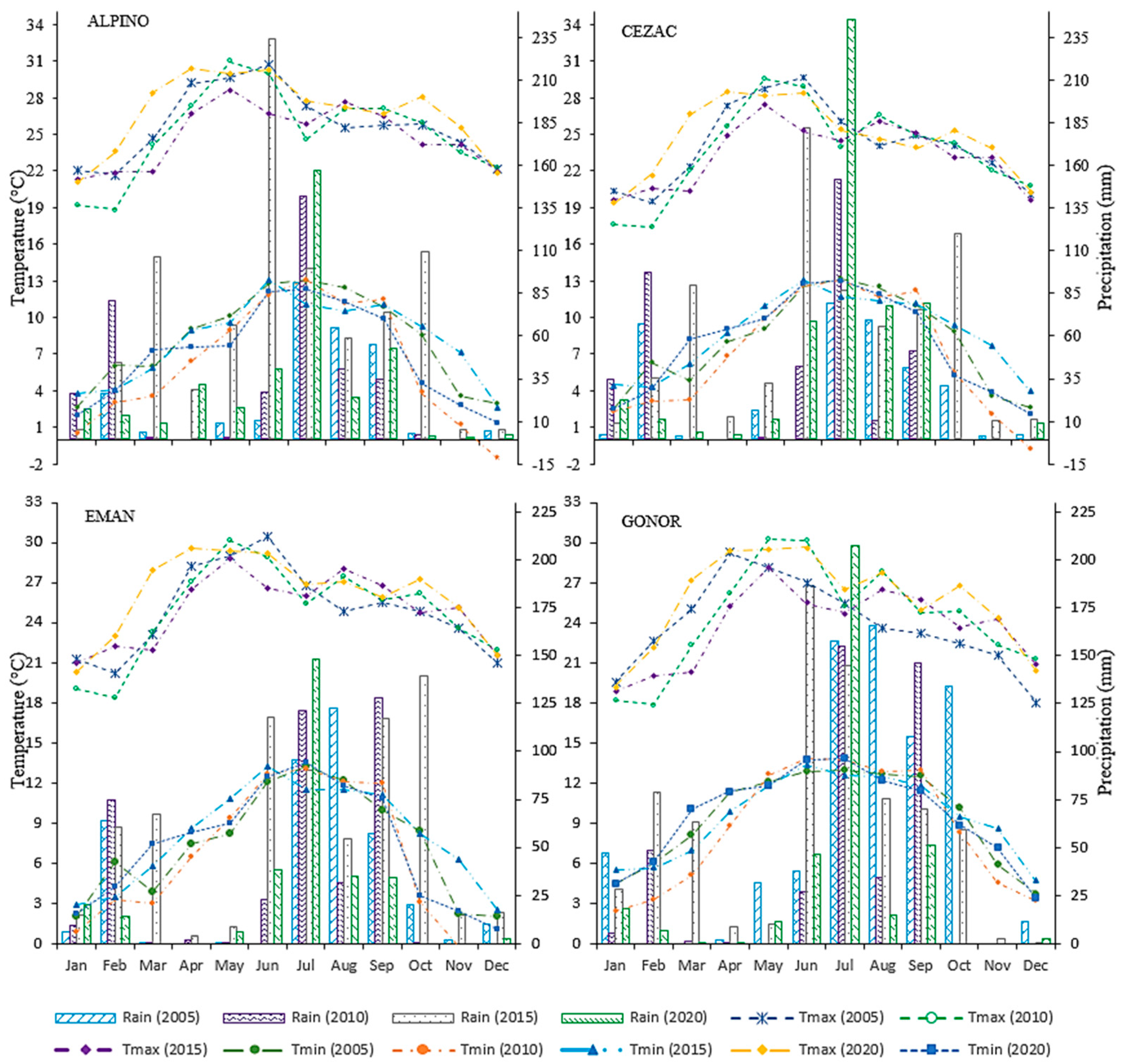
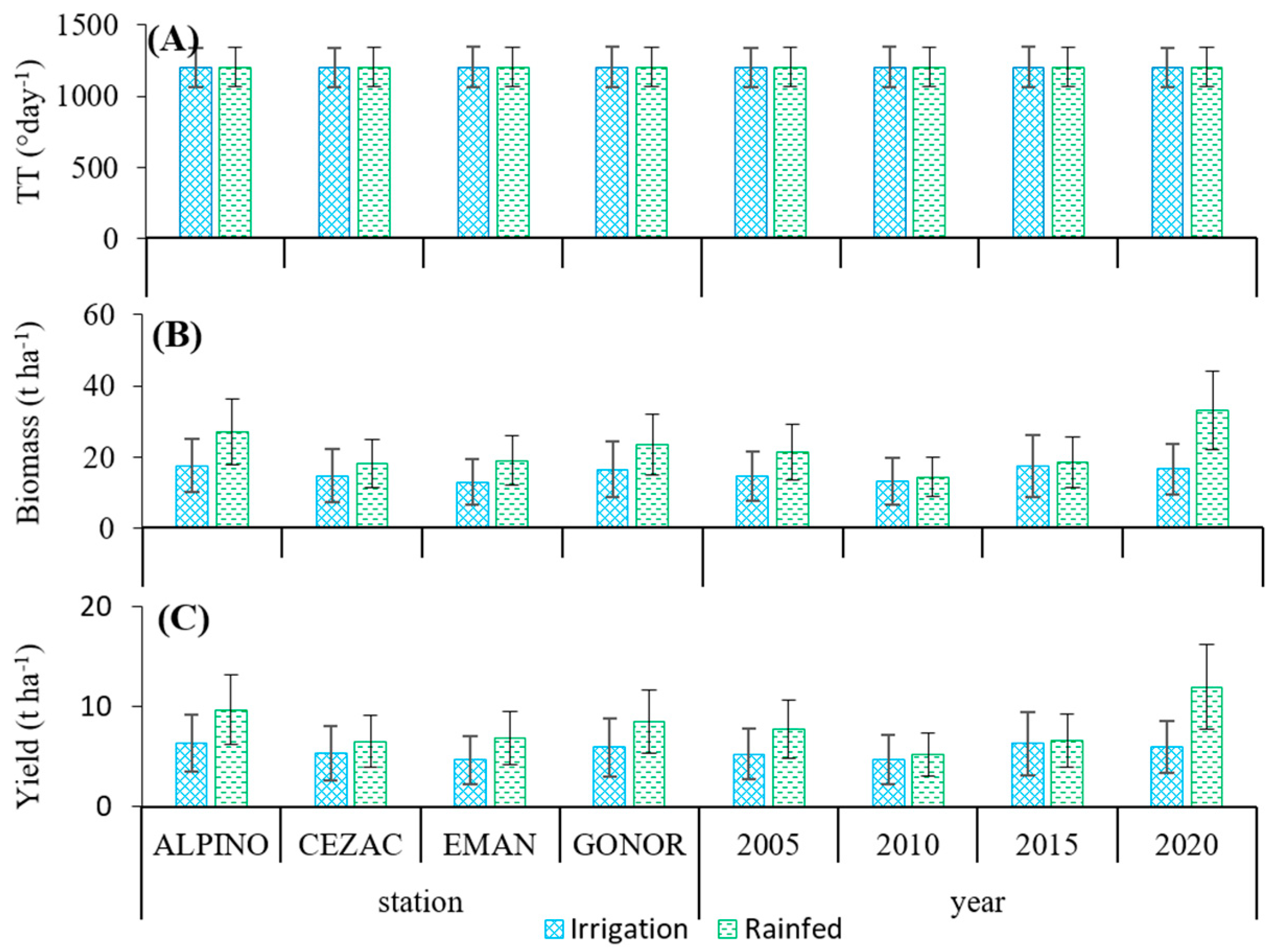
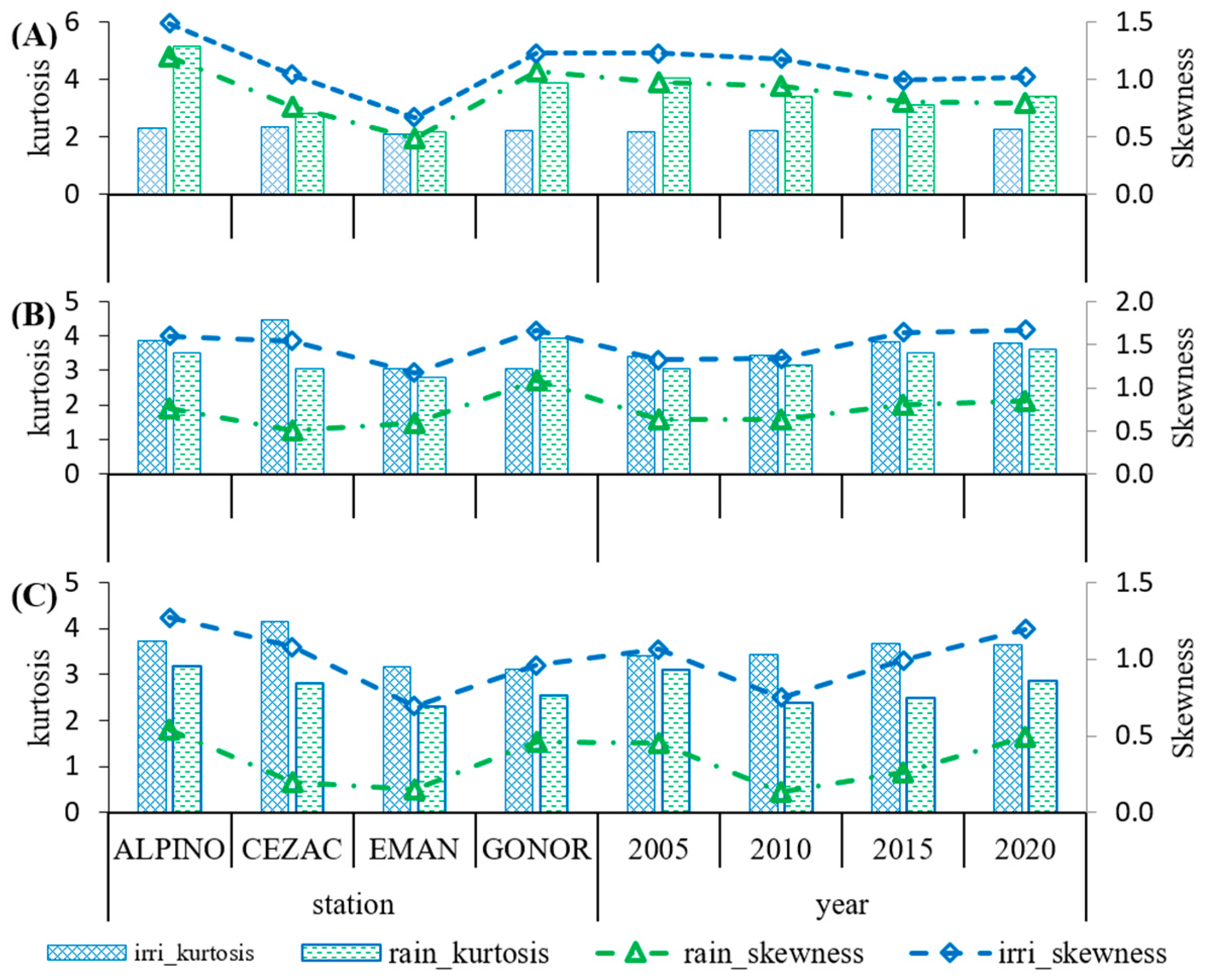
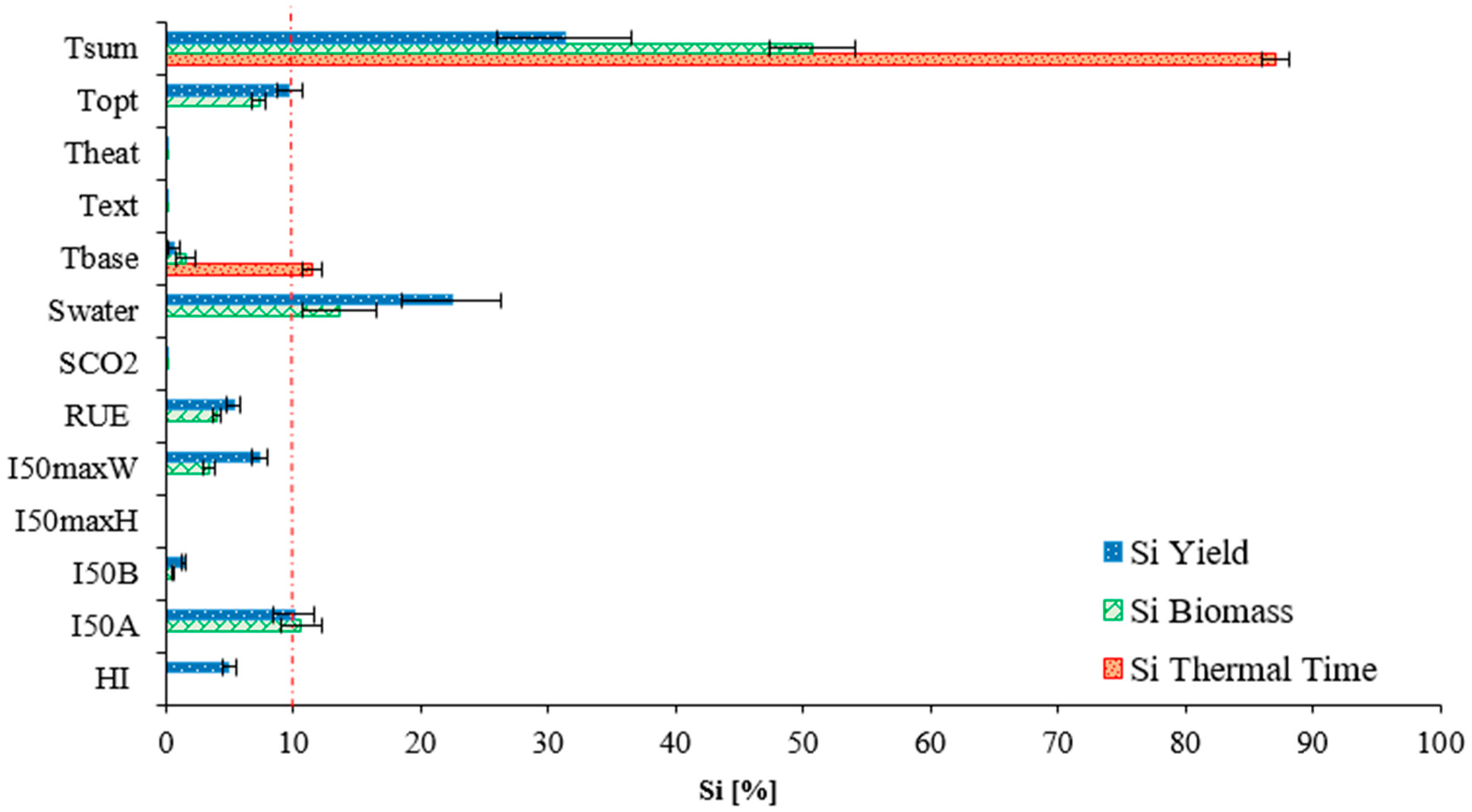
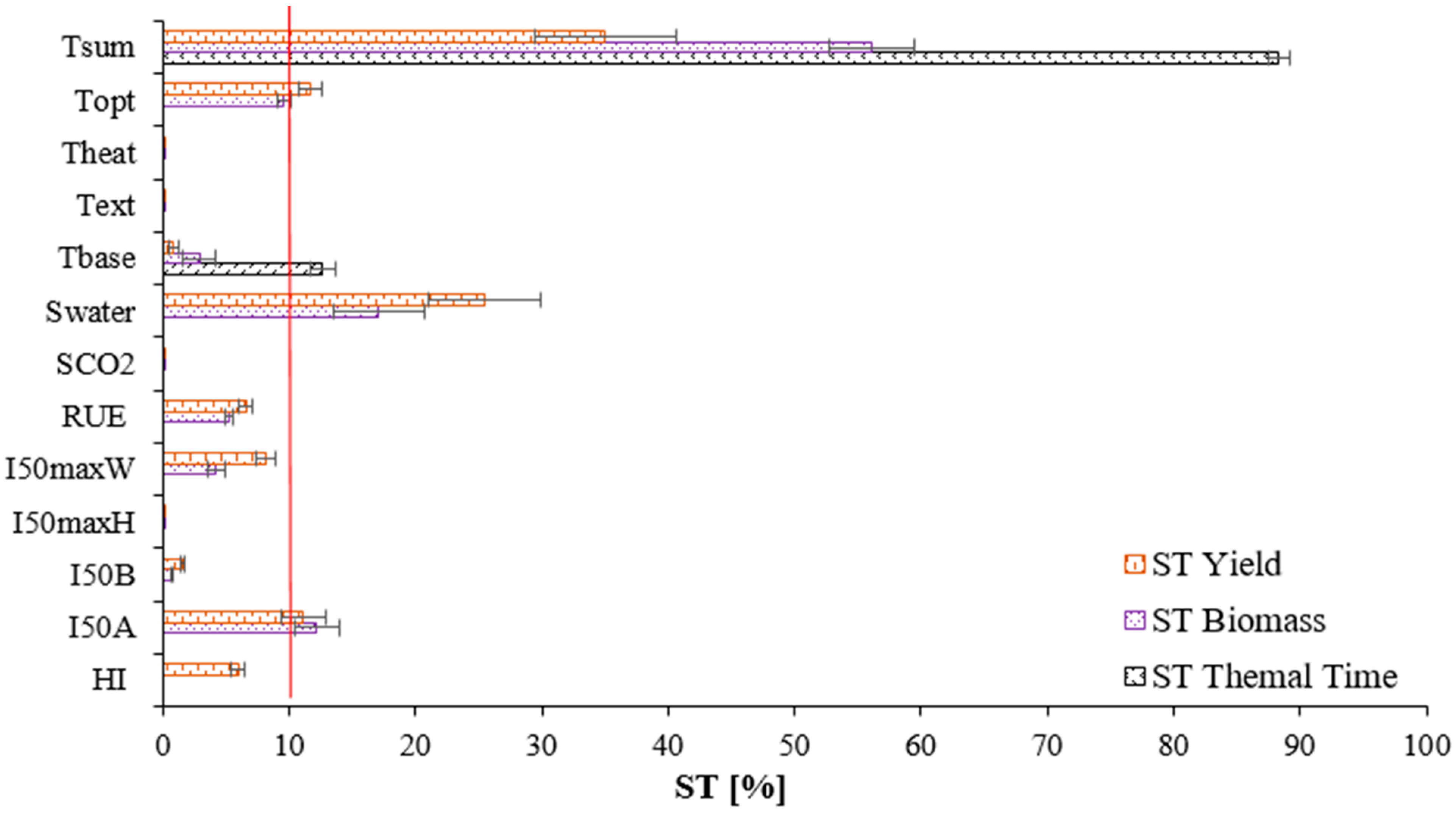
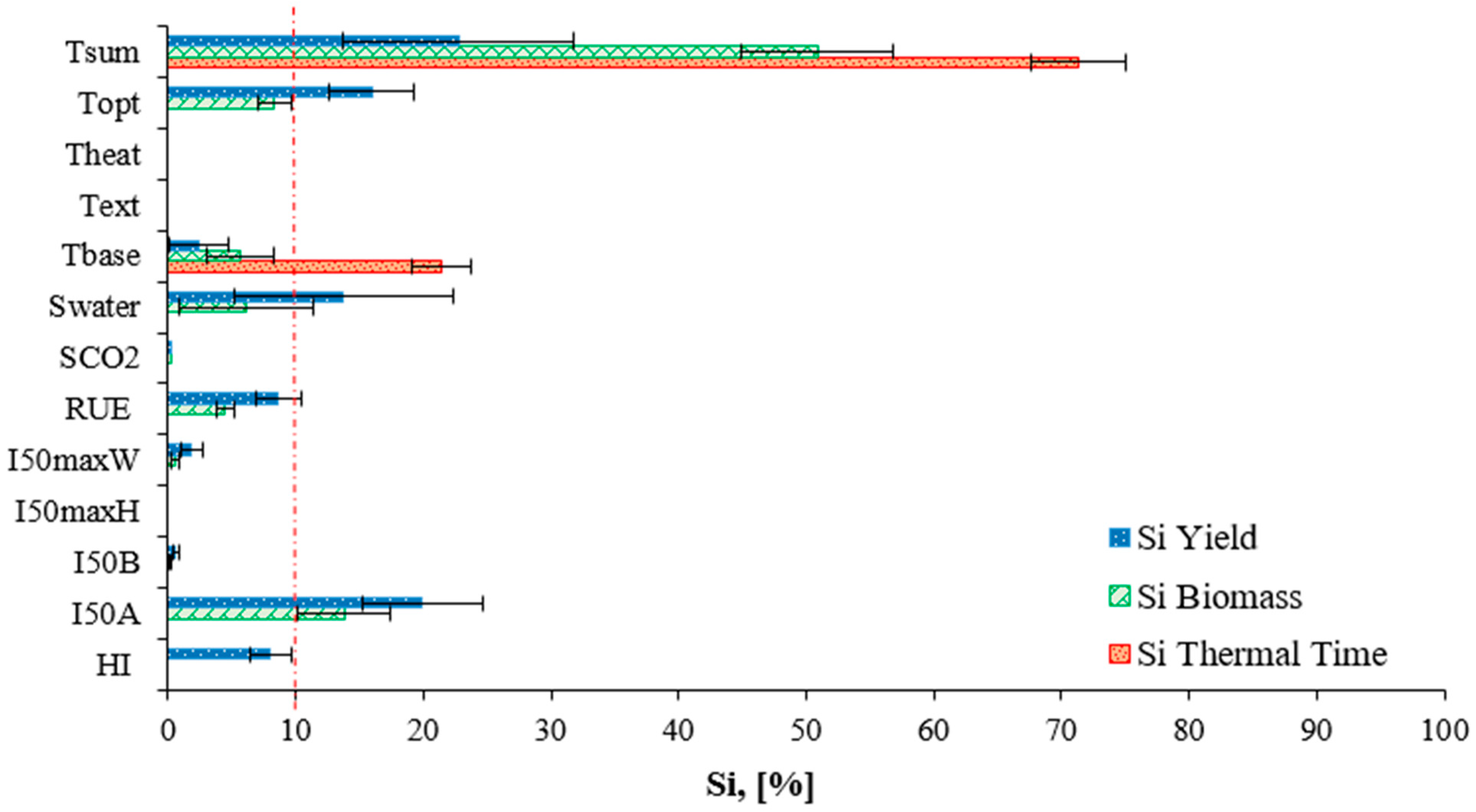
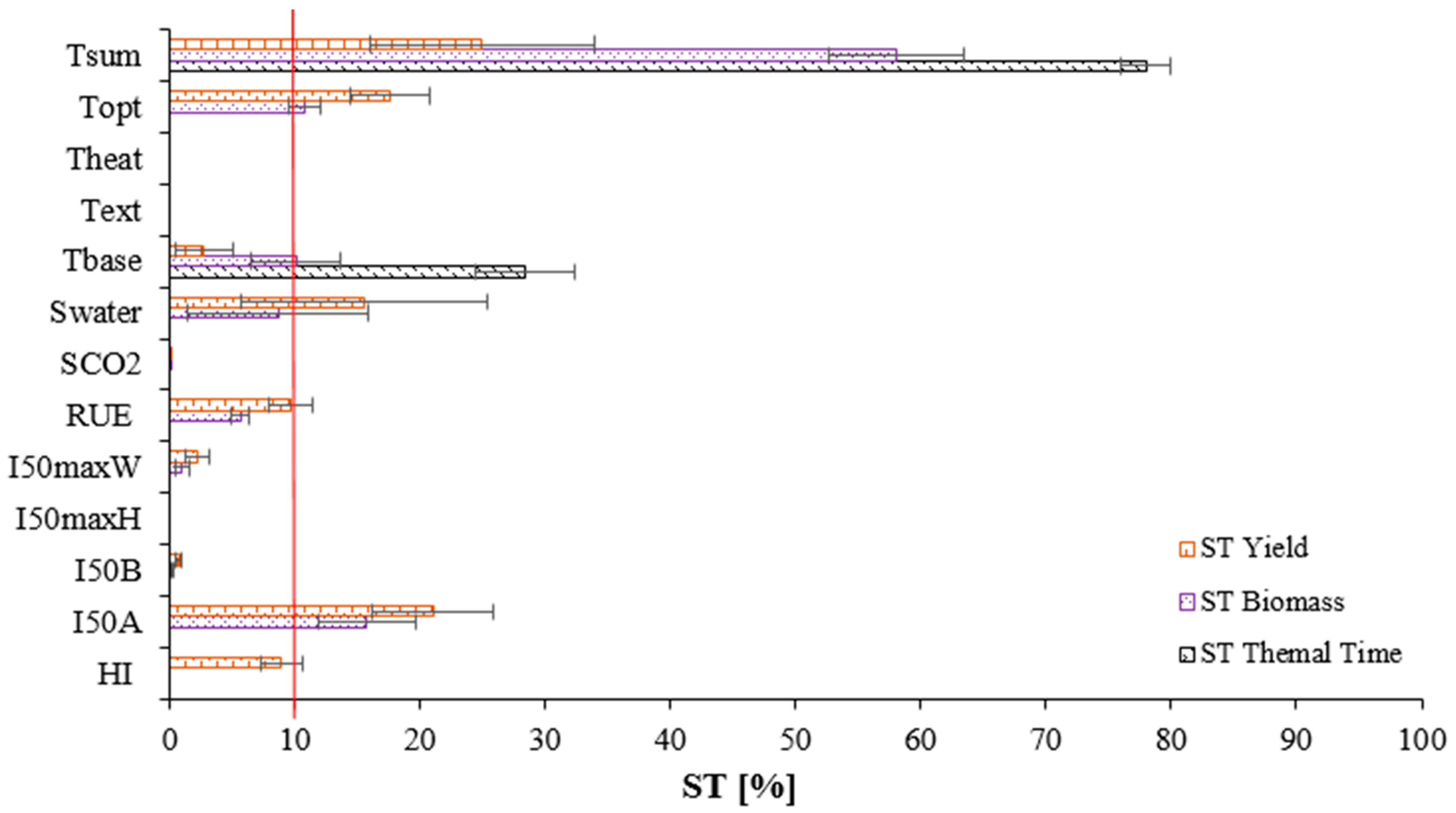
Publisher’s Note: MDPI stays neutral with regard to jurisdictional claims in published maps and institutional affiliations. |
© 2022 by the authors. Licensee MDPI, Basel, Switzerland. This article is an open access article distributed under the terms and conditions of the Creative Commons Attribution (CC BY) license (https://creativecommons.org/licenses/by/4.0/).
Share and Cite
Servin-Palestina, M.; López-Cruz, I.L.; Zegbe-Domínguez, J.A.; Ruiz-García, A.; Salazar-Moreno, R.; Medina-García, G. Spatiotemporal Uncertainty and Sensitivity Analysis of the SIMPLE Model Applied to Common Beans for Semi-Arid Climate of Mexico. Agronomy 2022, 12, 1813. https://doi.org/10.3390/agronomy12081813
Servin-Palestina M, López-Cruz IL, Zegbe-Domínguez JA, Ruiz-García A, Salazar-Moreno R, Medina-García G. Spatiotemporal Uncertainty and Sensitivity Analysis of the SIMPLE Model Applied to Common Beans for Semi-Arid Climate of Mexico. Agronomy. 2022; 12(8):1813. https://doi.org/10.3390/agronomy12081813
Chicago/Turabian StyleServin-Palestina, Miguel, Irineo L. López-Cruz, Jorge A. Zegbe-Domínguez, Agustín Ruiz-García, Raquel Salazar-Moreno, and Guillermo Medina-García. 2022. "Spatiotemporal Uncertainty and Sensitivity Analysis of the SIMPLE Model Applied to Common Beans for Semi-Arid Climate of Mexico" Agronomy 12, no. 8: 1813. https://doi.org/10.3390/agronomy12081813
APA StyleServin-Palestina, M., López-Cruz, I. L., Zegbe-Domínguez, J. A., Ruiz-García, A., Salazar-Moreno, R., & Medina-García, G. (2022). Spatiotemporal Uncertainty and Sensitivity Analysis of the SIMPLE Model Applied to Common Beans for Semi-Arid Climate of Mexico. Agronomy, 12(8), 1813. https://doi.org/10.3390/agronomy12081813






